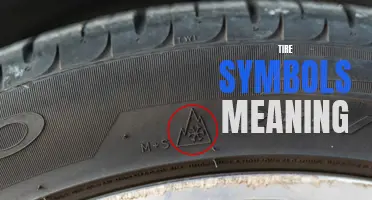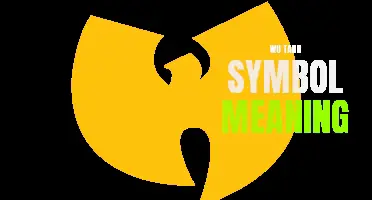
Supernatural symbols have always captivated human curiosity, as they hold deep spiritual and mystical meanings that go beyond our rational comprehension. From ancient civilizations to modern-day belief systems, these symbols have played a significant role in connecting humans to the realms of the supernatural. Whether it be the all-seeing eye representing divine knowledge or the triple moon symbolizing feminine energy, each supernatural symbol carries its own unique meaning and power. Join us on a captivating journey as we delve into the depths of the supernatural symbol meanings, unraveling their secrets and unraveling the mysteries of the unseen world.
What You'll Learn
- What is the significance of supernatural symbols in different cultures and religions?
- How do supernatural symbols convey meaning and messages to believers?
- Can supernatural symbols have different interpretations based on individual beliefs and experiences?
- Are there any common supernatural symbols that are recognized across various cultures?
- How do supernatural symbols play a role in rituals and ceremonies?

What is the significance of supernatural symbols in different cultures and religions?
Supernatural symbols have played a significant role in different cultures and religions throughout history. These symbols often represent powerful or divine entities, and are used to convey deeper meanings and connections to the spiritual world. They hold immense value and are considered sacred by believers. In this article, we will explore the significance of supernatural symbols in various cultures and religions.
One of the most prominent religions that uses supernatural symbols is Hinduism. In Hinduism, there are several symbols that represent different gods and goddesses. For example, the Om symbol is considered the most sacred and represents the cosmic sound of creation. It is believed to encompass the essence of the entire universe. Another well-known symbol is the Swastika, which symbolizes good luck, well-being, and prosperity. However, it is important to note that the Swastika has different connotations in various cultures and is not solely associated with Hinduism.
Similarly, in Buddhism, the supernatural symbol of the Lotus flower holds great significance. The Lotus represents purification and enlightenment, as it grows in muddy water but remains untainted. It symbolizes the journey towards liberation from the cycle of birth and death. The Dharmachakra, or Wheel of Law, is another important symbol in Buddhism. It represents the teachings of Buddha and the path to enlightenment.
Moving to the Western world, we find symbols deeply rooted in ancient Greek and Roman mythology. These symbols often represent the gods and goddesses of these pantheons. For example, the lightning bolt is associated with Zeus, the king of gods in Greek mythology. It symbolizes power, authority, and divine intervention. The trident, which is associated with Poseidon, god of the sea, represents control over water and the forces of nature.
In Norse mythology, supernatural symbols also hold great importance. The Valknut, a symbol of three interlocking triangles, is associated with Odin, the Allfather. It is believed to represent Odin’s power over fate and the afterlife. The Mjölnir, or Thor's hammer, is another powerful symbol in Norse mythology. It represents protection, strength, and the power to ward off evil.
Furthermore, many Native American cultures have their own unique supernatural symbols. The dreamcatcher, for example, is a well-known symbol that originated with the Ojibwe people. It is used to protect against bad dreams and negative energy. The medicine wheel, a circular symbol divided into four quadrants, represents harmony and balance in many Native American traditions.
In conclusion, supernatural symbols hold great significance in different cultures and religions. They serve as a way to connect with the divine and convey deeper meanings and beliefs. Whether it be Hinduism, Buddhism, Greek mythology, Norse mythology, or Native American traditions, these symbols provide believers with a tangible representation of their faith and spirituality. They are a testament to the diversity and richness of human religious and cultural expressions.
The Meaning behind the St. Jude Symbol: A Beacon of Hope and Healing
You may want to see also

How do supernatural symbols convey meaning and messages to believers?
Supernatural symbols have been used for centuries to convey meaning and messages to believers. These symbols are often rooted in religious and spiritual beliefs and are believed to possess supernatural powers. They are used as a way to communicate with supernatural beings or higher powers, as well as to represent concepts or ideas that are difficult to express through words alone.
One way that supernatural symbols convey meaning and messages is through their visual representation. These symbols often have distinct shapes, colors, and patterns that are universally recognized by believers. For example, the Christian cross is a powerful symbol that represents the crucifixion of Jesus Christ and is a reminder of his sacrifice and the promise of redemption.
In addition to their visual representation, supernatural symbols often have a deep cultural and historical meaning attached to them. These symbols can carry a wealth of religious and spiritual significance that has been passed down through generations. For example, the Egyptian ankh symbolizes life and immortality, while the Hindu Om symbol represents the unity of the divine.
Moreover, supernatural symbols often have specific rituals or practices associated with them, which further reinforce their meaning and messages. For example, believers may use supernatural symbols during prayer or meditation to focus their thoughts and intentions. These symbols act as powerful reminders of their faith and the presence of the supernatural.
Furthermore, supernatural symbols can also serve as a form of protection or guidance for believers. Many cultures have symbols that are believed to ward off evil spirits or bring good luck. These symbols are often worn as jewelry or displayed in homes and places of worship as a way to seek supernatural protection and blessings.
Overall, supernatural symbols play a significant role in conveying meaning and messages to believers. They provide a visual representation of complex concepts, carry deep cultural and historical significance, have specific rituals attached to them, and offer protection and guidance. Through these symbols, believers are able to connect with the supernatural and find comfort, inspiration, and a sense of belonging within their faith.
Decoding the Mystical Meanings of the Monas Hieroglyphica Symbol
You may want to see also

Can supernatural symbols have different interpretations based on individual beliefs and experiences?
Supernatural symbols have long played a significant role in various cultures and belief systems across the world. From ancient civilizations to modern-day religions, these symbols are often used to represent spiritual concepts and supernatural forces. However, the interpretation of these symbols can vary greatly based on individual beliefs and experiences.
One of the reasons for this variation is the diversity of belief systems and religions. Different cultures and religions possess their own unique set of symbols and meanings. For example, the cross is commonly associated with Christianity and represents the crucifixion and resurrection of Jesus Christ. However, in Hinduism, the swastika symbolizes peace and good fortune. These varied interpretations are shaped by the beliefs and experiences of individuals within these respective religious communities.
Furthermore, personal experiences and beliefs can also influence the interpretation of supernatural symbols. For instance, a person who has had a positive encounter with a spirit or entity may associate certain symbols with protection or guidance. On the other hand, someone who has had a negative experience may perceive the same symbol as a warning or threat. These personal experiences and beliefs can greatly impact how individuals view and interpret supernatural symbols.
Moreover, cultural and historical context also plays a significant role in shaping interpretations. Symbols often have layered meanings that are influenced by the time and place in which they are used. For example, the pentagram, which is commonly associated with witchcraft and occult practices, was used as a symbol of protection in ancient Mesopotamia. The interpretation of this symbol has evolved over time and now carries different connotations based on cultural and historical perspectives.
In addition, individual beliefs and experiences can lead to the creation of entirely new interpretations of supernatural symbols. As individuals engage with these symbols, they may find personal meaning and connections that are unique to their own experiences. This can lead to the development of new beliefs and interpretations that diverge from traditional or commonly accepted meanings.
In conclusion, supernatural symbols can indeed have different interpretations based on individual beliefs and experiences. The diversity of cultures, religions, personal beliefs, and historical contexts all contribute to this variation. It is essential to approach these symbols with an open mind and respect for the different interpretations they may hold for different individuals. By doing so, we can foster a deeper understanding and appreciation for the multifaceted nature of supernatural symbols.
Decoding the Bobcat Warning Light Symbols: Understand Their Meanings
You may want to see also

Are there any common supernatural symbols that are recognized across various cultures?
Supernatural symbols have been an integral part of human culture since time immemorial. Across various cultures, there are indeed several common supernatural symbols that hold significant meanings and are recognized universally. These symbols often represent spiritual beliefs, nature, mystical powers, and the connection between the physical and metaphysical realms. Let's explore some of these symbols that transcend different cultures and their interpretations.
The Eye:
The Eye, often referred to as the "All-Seeing Eye," is a potent symbol found in numerous cultures worldwide. It represents divine knowledge, enlightenment, and the ability to see beyond the physical realm. The Eye is commonly associated with a higher power or a cosmic force that observes and guides human actions.
The Pentagram:
The Pentagram, a five-pointed star enclosed in a circle, has been a symbol of magic and spiritual protection in various cultures. It is synonymous with the five elements - earth, air, fire, water, and spirit, and represents balance and harmony. The Pentagram also signifies the connection between the spiritual and physical worlds.
The Cross:
The Cross is one of the most recognizable symbols in the world, revered in Christianity and several other religions. It represents sacrifice, redemption, and spiritual transformation. The vertical line of the Cross signifies the connection between heaven and earth, while the horizontal line symbolizes the unity of all creation.
The Moon:
The Moon symbolizes feminine energy, intuition, and the ebb and flow of life in numerous cultures. It often represents the connection between the spiritual realm and the cycles of nature. The Moon's phases also symbolize different stages of life and the ever-changing nature of existence.
The Serpent:
The Serpent is a symbolic creature found in numerous ancient cultures such as ancient Egypt, Mesopotamia, and Mesoamerica. It represents wisdom, knowledge, regeneration, and healing. Often depicted as a creative force, the Serpent symbolizes the dualistic nature of life and the eternal cycle of birth, death, and rebirth.
The Tree of Life:
The Tree of Life is a universal symbol found in cultures spanning from ancient civilizations to modern religions. It represents the interconnectedness of all life forms and symbolizes spiritual growth, wisdom, and immortality. The Tree of Life's roots delve into the earth, while its branches reach for the heavens, signifying the connection between different realms.
The Ankh:
Originating in ancient Egypt, the Ankh is a powerful symbol representing eternal life and vitality. It combines the symbols of both masculine and feminine energies, with a loop representing the feminine womb and the cross symbolizing masculine energy. The Ankh is believed to bring protection, fertility, and spiritual enlightenment.
The Thunderbolt:
The Thunderbolt, often depicted as a lightning bolt, represents sudden enlightenment, divine intervention, and transformation. Found in various ancient mythologies and belief systems, it symbolizes the moment of illumination and the awakening of spiritual awareness.
While these symbols are recognized across cultures, their interpretations and significance may vary. They serve as a reminder of the mystical and interconnected nature of existence and provide a common thread that unifies humanity's spiritual beliefs. Regardless of cultural differences, these symbols continue to inspire awe and reverence, much like they have done for centuries.
The Hidden Meanings Behind the Double Triangle Symbol
You may want to see also

How do supernatural symbols play a role in rituals and ceremonies?
Supernatural symbols have played a crucial role in rituals and ceremonies for centuries. These symbols, often imbued with deep spiritual significance, are believed to represent and communicate the divine presence, invoking supernatural powers and creating a connection between the human and the spiritual realms.
Symbols are essential components of rituals and ceremonies as they serve as conduits for expressing and manifesting the desired spiritual intentions. They hold a symbolic language that encapsulates complex ideas, emotions, and beliefs, making them powerful tools for ritualistic practices.
One common example of a supernatural symbol used in ceremonies is the pentagram. This five-pointed star, often associated with Wiccan and pagan practices, is believed to represent the five classical elements - earth, air, fire, water, and spirit. During rituals, the pentagram is drawn or placed in sacred spaces to invoke these elements and their respective qualities. For example, the earth element represents stability and grounding, while fire symbolizes transformative energy. By incorporating the pentagram symbol into a ceremony, practitioners can tap into these elemental energies and channel them for their intended purposes.
Another significant supernatural symbol is the cross, which holds immense religious significance for Christians. The cross is believed to represent the crucifixion and resurrection of Jesus Christ. During religious ceremonies, the cross is prominently displayed, worshipped, and sometimes even carried by priests and devotees. Its presence serves as a reminder of the sacrifice and salvation brought about by Jesus, reinforcing the central message of Christianity.
In addition to their communicative role, supernatural symbols also create a sacred space and set the ceremonial atmosphere. Symbols such as the ankh, the Om symbol, the yin and yang, or the Eye of Horus are often incorporated in rituals to sanctify the space and invoke divine energies. These symbols act as focal points, attracting and harnessing spiritual energies and directing their flow within the ceremonial setting.
Moreover, supernatural symbols are often employed to invoke the presence of specific deities or spiritual forces. For instance, in Hindu rituals, the image or symbol of a particular deity, such as Lord Ganesha or Goddess Lakshmi, is used to invite their divine presence and seek their blessings. These symbols are considered sacred representations of the deities and serve as a gateway through which devotees can establish a direct connection with the divine.
While the precise meaning and significance of supernatural symbols may vary across different cultures and belief systems, their role in rituals and ceremonies remains constant. They serve as embodiments of spiritual concepts, conduits for sacred energies, and visual representations of the mystical forces at play.
In conclusion, supernatural symbols have a profound impact on rituals and ceremonies. They facilitate the expression of spiritual intentions, create sacred spaces, invoke divine presence, and serve as visual representations of complex spiritual concepts. Whether it be the pentagram, the cross, or other symbols, their use in rituals and ceremonies holds immense value and serves as a bridge between the earthly and the spiritual realms.
The Symbolic Meaning Behind the Sacred Symbols of Baptism
You may want to see also
Frequently asked questions
In supernatural symbolism, the pentagram is often associated with protection and spiritual transformation. It is believed to have the power to invoke and banish spirits, and is commonly used in rituals and spell work. The five points of the pentagram represent the elements of earth, air, fire, water, and spirit, and the interconnectedness of these forces in the spiritual realm.
The eye symbol, often referred to as the all-seeing eye or the eye of providence, is a powerful and ancient symbol in supernatural symbolism. It is said to represent divine and supernatural knowledge, and the ability to see and understand things beyond the physical realm. It is often associated with illumination, enlightenment, and spiritual awakening.
In supernatural symbolism, the crescent moon is often associated with feminine energy, intuition, and divine goddesses. It represents the waxing and waning cycles of the moon, and is believed to enhance psychic abilities and connect an individual with their intuitive and spiritual side. It can also symbolize the divine feminine energy present in the Universe and the power of creation.







